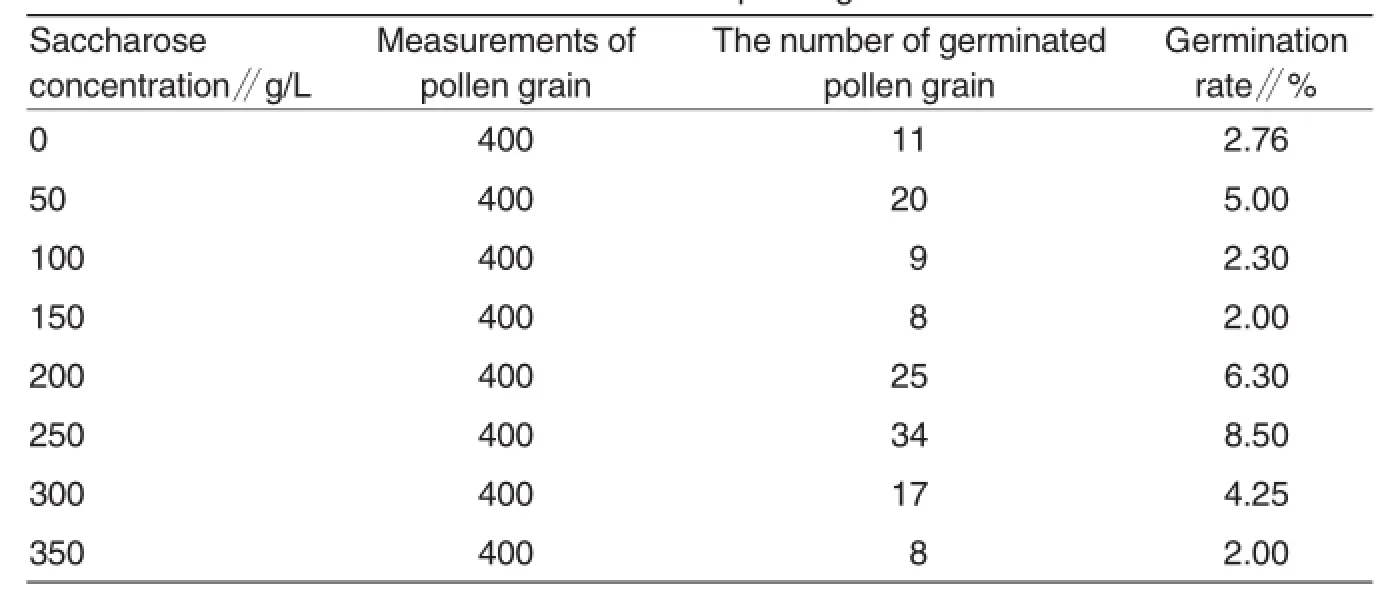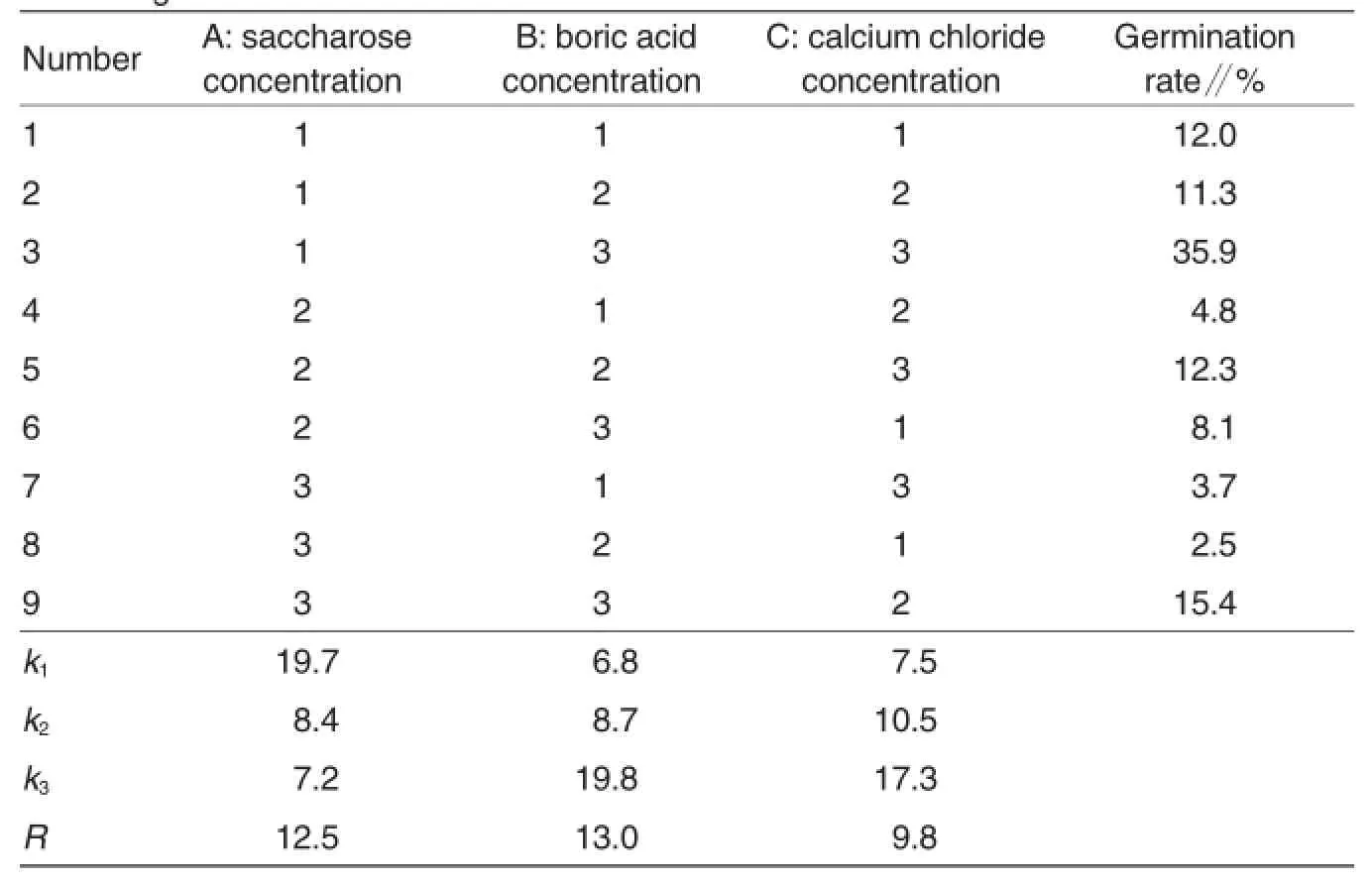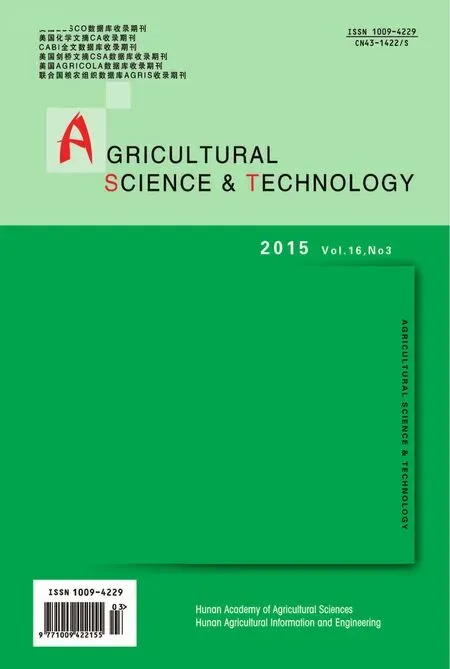Characteristics of Pollen Germination and Storage of Zygocactus truncates
Yuping Ll,Fengxia LUO,Yunjie SHENGJinling Institute of Technology College of Horticulture,Nanjing 210038,China
Characteristics of Pollen Germination and Storage of Zygocactus truncates
Yuping Ll,Fengxia LUO*,Yunjie SHENG
Jinling Institute of Technology College of Horticulture,Nanjing 210038,China
The research,based on pollens of Zygocactus truncates during full-bloom period,selected suitable culture medium and temperature for pollen germination and explored the effects of storage temperatures and pollen collection methods on pollen vitality of Zygocactus truncates and the results showed that the culture medium containing 200 g/L saccharose,20 mg/L boric acid,and 20 mg/L calcium chloride is suitable for pollen germination of Zygocactus truncates;when the temperature kept below 20℃,pollen germination period last short,and germination rate kept higher;pollen germination performed better with filaments,and pollen tube grew well.
Zygocactus truncates;Pollen germination;Fluid medium;Storability
Z ygocactus truncates,endemic to Brazil,has leafless green stems and the stems are composed of strongly flattened segments,having“teeth”of varying shapes along their edges and at the ends. The flowers are held at a constant angle above the horizontal with the higher side different from the lower side and of various colors,including red,orange,pink and white[1].In Germany and America,Zygocactus truncates is cultivated and produced in a large scale,and it is one of major potted flowers in winter.In the 1980s,Zygocactus truncates was introduced to China and is produced in a small scale in Tianjin,Dalian,Qingdao,Shanghai,Guangzhou,and Xiamen.Pollen is part of the male gametophyte of higher plants,delivering male genetic materials at sexual propagation and constituting important materials of sporopollen analyzing,swarm cultivation and drug manufacturing[2-3].The research,based on pollens of Zygocactus truncates during full-bloom period,selected suitable culture medium and temperature for pollen germination and explored the effects of storage temperatures and pollen collection methods on pollen vitality of Zygocactus truncates in order to provide references for hybridization of Zygocactus truncates.
Materials and Methods
Materials
The pollens of Zygocactus truncates during full-bloom period were taken as test materials.
Methods
Selection of liquid medium for in vitro pollen germination
The test designed 8 saccharose concentrations,involving 0,50,100,150,200,250,300 and 350 g/L in order to select a concentration suitable for pollen germination.On basis of simple factor design of experiment,boric acid and calcium chloride were added as per orthogonal experimental design (Table 1)to discuss liquid medium for pollen germination of Zygocactus truncates.Specifically,fresh pollen was collected during 08:00-09:00,added into a glass tube,and well oscillated.Then,pollen was scattered on nutrient solutions and well mixed with the solution.It is notable that every nutrient solution was repeat-ed for four times.Subsequently,a glass slide was placed in a petri dish,which was placed in a room at 25℃and observed once every 2 h.The final measurement time started when twice measurements of germination rates kept basically the same.For every repetition,100 pollens would be observed and the number of germinated pollen was computed as per the standard that the length of pollen tube exceeded diameter of pollen grain,as follows:
Germination rate=The number of germinated pollen grain/The number of pollen×100%.
Effects of cultivation temperature on pollen germination time After determination of the suitable culture medium of in vitro germination of pollen,pollens were then placed in an incubator at 15 and 20℃.The test was observed once every 2 h and changed to once every one hour after pollen germination,until the observed data changed insignificantly.Still,the measurements of pollen germination rate were the same as the equation above.
Effects of storage temperature on pollen germination time At the beginning,loose pollens were collected and dried in the shade.Then,pollens were put into a glass tube which was labeled and placed in the shade and then a refrigerator at 4 and-20℃,respectively.It is notable that pollen germination rate was observed once every two days until pollen germination activity was below 5%.The nutrient solution contained 200 g/L saccharose,20 mg/L boric acid,and 20 mg/L calcium chloride,and the culture temperature was 20℃.In addition,the measurements of pollen germination rate were the same as the equation above.
Effects of pollen collection methods on pollen germination activity after storage The dehiscent anthers and anthers with 1 cm filaments were put into a glass tube and stored at 4℃.Pollen germination rate was measured once every 4 days.The anther culture solution contained 200g/L saccharose,20 mg/L boric acid,and 20 mg/L calcium chloride,and the culture temperature was 20℃.In addition,the measurements of pollen germination rate were the same as the equation above.
Results and Analysis
Effects of fluid medium on pollen germination
Effects of saccharose concentration on pollen germination When pollens were cultured with saccharose at different concentrations,pollen would swell.After 3 h,pollen tubes germinated and grew from germinal furrows.After 25 h,the germination process ended and pollen germination kept almost the same after 29 h.As shown in Table 2,when saccharose concentration was 250 g/L,pollen germination rate reached the peak at 8.5%,and the rates of rest treatments generally maintained lower.
The orthogonal test of culture medium of in vitro germination of pollen As shown in Table 3,pollen germination rate achieved the peak at 35.9%in the culture medium containing 200 g/L saccharose,20 mg/L boric acid,and 20 mg/L calcium chloride and the effects from high to low were boric acid>saccharose>calcium chloride.It is notable that highly-concentrated saccharose would prevent pollen germination,but suitable boric acid and calcium chloride would promote pollen germination.The optimal culture solution can be concluded containing 200 g/L saccharose,20 mg/L boric acid,and 20 mg/L calcium chloride.
Effects of culture temperature on germination time
As shown in Table 4,pollens germinated earlier in an incubator at 20℃,with a higher germination rate. Specifically,pollens germinated 2 h after cultured in an incubator,which was 1 h earlier compared with the situation at 15℃.After 29 h,pollen germination ended,which was 3 h fewer compared with that at 15℃.
Effects of storage temperature on pollen germination rate
It can be concluded from Fig.1 that pollen germination rate dropped fast at room temperature and the rates were 30%,23%,and 18%after 1,2 and 3 d storages.At 4℃,the germination rate was 14%5 d after storage,8%9 d after storage and below 5%12 d after germination.It can be concluded that pollen of Zygocactus truncates can be stored for 12 d at 4℃.After 3 d storage at-20℃,germination rate of pollen was 18%,13%after 5 d storage and 10%after 10 d storage.

Table 1 The orthogonal experiment of pollen germination of Zygocactus truncates with liquid medium

Table 2 Effects of saccharose concentration on pollen germination rate
Effects of pollen collection methods on germination rate
As shown in Fig.2,to collect pollen with filament extended storage periods of pollen and the germination rate still kept over 5%after 15 d storage.What’s more,with pollen stored for 9 d with filament,the number of germinated pollen would be much more and pollen tubes grew well.Incontrast,the number of germinated pollen was small at collecting pollen without filaments.

Table 3 The orthogonal test results and range analysis of fluid medium for pollen in vitro germination

Table 4 Effects of culture temperatures on pollen germination time
Conclusions and Discussions
The research indicated that the culture medium containing 200 g/L saccharose,20 mg/L boric acid,and 20 mg/L calcium chloride is suitable for pollen germination of Zygocactus truncates. Specifically, saccharose plays the role of supplying energy and adjusting osmotic pressure during pollen germination[4].Highly-concentrated saccharose would prevent pollen germination,which coincided with the conclusion of Zhang et al.and He et al.[5-6].Furthermore,boric acid at a suitable concentration would promote pollen germination and pollen tube growth[7-10].The research suggested that pollen germination rate reached the highest with boric acid concentration at 20 mg/L,possibly caused by the complex formed by boric acid and saccharose,advancing sugar absorption and metabolism[11-12]. On the other hand,temperature also has effects on pollen germination. Jiang et al.believed that the temperature suitable for pollen germination and growth is in the range of 25-30℃,and the temperature of 30℃ is optimal,when pollen germination rate and pollen tube length both reached the highest.In contrast,with temperature below 20℃ or higher than 35℃,pollen germination rate was lower and pollen tube grew slowly[13].When the temperature kept below 20℃,pollen germination period last short,and germination rate kept higher.Therefore,the temperature at 20℃is suitable for Zygocactus truncates growth.It is clear that low temperature would reduce pollen respiration and other physiological functions,which is conductive to long-term maintenance of pollen vitality,because low temperature reduces respiration strength and enzymatic activity[14].Sun et al.believed that frozen storage of lily pollen performed the best at 4℃[15].The research indicated that germination rate of pollen of Zygocactus truncates was decreasing at room temperature and can be stored as many as 5 d,10 d at 4℃,and 8 d at-20℃.It is notable that pollen with filaments germinated well and pollen tube grew well,possibly caused by nutrients supplied by filaments for pollen,extending pollen death.
References
[1]LI JZ(栗进朝),YAO LL(姚林林).Selection choices and cultivation technology of Zygocactus truncates(蟹爪兰品种选择及栽培技术)[J].Northern Horticulture(北方园艺),2009(5):205-206.
[2]YANG HY(杨弘远).New progress of pollen research(花粉研究的新进展)[J]. Journal of Wuhan University(Natural Science Edition)(武汉大学学报:自然科学版),1977(2):78-87.
[3]WANG JW (汪劲武).Adaptation of plants’pollination(植物传粉的适应)[J]. Bulletin of Biology(生物学通报),1980(2):26-27.
[4]PAN RC(潘瑞炽).Plant Physiology(植物生理学)[M].Beijing:Higher Education Press(北京:高等教育出版社),2001: 260.
[5]ZHANG SL(张绍铃),CHEN DX(陈迪新),KANG L(康琅),et al.Effects of medium components and pH on pollen germination and tube growth in pear(培养基组分及pH值对梨花粉萌发和花粉管生长的影响)[J].Acta Botanica Boreali-Occidentalia Sinica(西北植物学报),2005,25(2):225-230.
[6]HE Q(何琪),HE F(何芳),LIU P(刘鹏),et al.Effects of PEG-4000, saccharose and pH on pollen germination of Heptacodium miconioides(PEG-4000、蔗糖及pH值对七子花花粉萌发的影响)[J].湖北农业科学,2006,45(2):214-216.
[7]NIAN YX(年玉欣),LUO FX(罗凤霞),ZHANG Y(张颖),et al.Studies on the
(Continued on page 466)
蟹爪兰花粉萌发及贮藏特性
李玉萍,罗凤霞*,盛芸洁 (金陵科技学院园艺学院,江苏南京 210038)
以蟹爪兰花粉为材料,采用液体培养法研究培养基组成、培养温度、花粉采集方式、贮藏温度等对花粉萌发特性的影响。结果表明:适宜蟹爪兰花粉萌发的液体培养基为:200 g/L蔗糖+20 mg/L硼酸+20 mg/L二氯化钙;20℃下蟹爪兰花粉萌发时间比较短,且萌发率较高;有花丝的花粉萌发较好,花粉管生长良好。
蟹爪兰;花粉萌发;液体培养基;贮藏性
江苏省高校自然科学研究项目(编号:10kjd210005)。
李玉萍(1976-),女,甘肃酒泉人,博士,副教授,主要从事园林植物遗传育种和应用研究,E-mail:lyp@jit.edu.cn。*通讯作者,教授,E-mail:luofx@jit.edu.cn。
2015-01-01
2015-02-13
Supported by the Natural Science Foundation of the Jiangsu Higher Education Institutions of China(10kjd210005).
.E-mail:luofx@jit.edu.cn
January 1,2015Accepted:February 13,2015
 Agricultural Science & Technology2015年3期
Agricultural Science & Technology2015年3期
- Agricultural Science & Technology的其它文章
- Analysis of the Causes of Continuous Cropping Obstacles for Atractylodes macrocephala Koidz in Pingjiang County and Its Control Methods
- Overview of Pharmacological Research on Adonis L.
- Research Progress of Special Wheat Nutrition Components and Application
- Human Settlements in Rural-urban Fringe
- The Effect of Three New Fungicides against Rice Sheath Blight in Field Experiment
- Overview of Pharmacological&Ecological Research of Scirpus tabernaemontani Gmel
